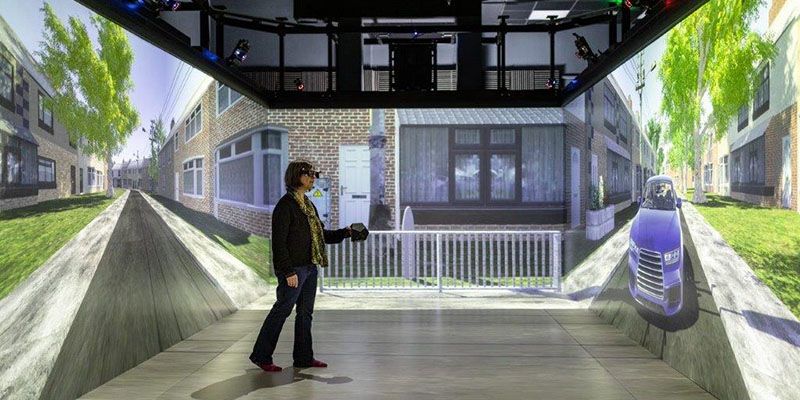Cities are demanding places to navigate. As road users, we encounter a variety of other cyclists, pedestrians and drivers, while negotiating a patchwork of signs, traffic lights, vehicles, and road markings.
City planners, policymakers, and vehicle manufacturers want to make these complicated environments as safe as possible, while also tackling other transport-related challenges such as congestion and air pollution. But how can they tell if a change they plan to make is going to improve things, or simply make them worse? As new technologies are introduced to our vehicles and roads, it is important to understand their impact on individuals and our transport ecosystem.
One approach is to use simulations of the road and vehicles to enable the safe testing of interactions between road users in current and future environments. Over the past 29 years, researchers at the University of Leeds have used a range of “human-in-the-loop” virtual reality simulators to study how people respond to new and developing technologies. They have developed a world-class suite of facilities, that are currently the most advanced in the UK.
Housed together at the Virtuocity facility, this set of linked simulators provides a highly immersive and adaptable virtual environment for studying the factors that influence human behaviour so that future road transport can be safer, more efficient, and sustainable.

“With the introduction of more advanced driver assistance systems in our cars and other technologies on the road, it is becoming ever more important to understand how these systems affect road user behaviour and safety,” explains Professor Natasha Merat, Chair in Human Factors of Transport Systems at the University of Leeds, who leads research at Virtuocity.
As autonomous vehicles become more common on our roads, this kind of research is going to be crucial for informing decisions about the technology's development. For example, it will be important to understand how human road users and autonomous vehicles interact at certain traffic hotspots, such as at junctions or narrow sections of road where oncoming vehicles may need to give way to each other.
“If you know the vehicle coming from the other direction is autonomous, how might that change your behaviour?” asks Peter Woodthorpe, programme manager of Virtuocity. “How aggressive or submissive does the autonomous vehicle need to be in that situation to ensure it doesn’t just get trapped with a large queue of traffic behind it?”
This is just the sort of situation that the researchers at Virtuocity can test. The team includes engineers, industrial designers, computer scientists, psychologists, ergonomists, and human factors specialists. They work with a wide range of partners, from car manufacturers and tier-one technology suppliers to road infrastructure agencies, such as National Highways.
Safe and responsive
As the simulation software is programmed in-house by the team, it can be tailored to the exact needs of the experiment. With eight degrees of motion and the ability to generate realistic acceleration forces, the simulator provides an immersive environment, in a real car, which is encased in a bespoke dome.
An array of sensors can monitor driving behaviours such as steering and braking, reaction to external events, distraction and stress levels. These can be used to study, for example, how drivers behave at junctions when faced with different levels of traffic, or reaction times while tired or when talking on a mobile phone.
The simulator also allows the team to set up scenarios that are only rarely encountered in the real world and could be potentially dangerous to do on test tracks.
Virtuocity allows us to look at these interactions in a safe environment, investigating the effect of technologies not yet in production.
“We might also look at what the reaction times might be when an autonomous vehicle asks a driver to take back control,” explains Peter. "Doing those on a test track is going to be expensive and could be potentially dangerous if we start adding in additional cognitive loading tasks to see how that might distract the driver.”
On foot and on wheels
The pedestrian simulator – the Highly Immersive Kinematic Experimental Research (HIKER) laboratory – uses “CAVE-based” technology by projecting high-definition images onto glass plate walls that adapt to the user’s gaze and head position. Users can walk freely within the 9m by 4m room, so they can interact with a variety of situations, such as examining behaviour at pedestrian crossings.
The truck simulator has three degrees of motion and has been used to test the design of cycle lanes, for example, and to examine how truck driver behaviour changes at night in different weather conditions.
Most recently, the team have added the capability to connect the driving simulators and HIKER laboratory together so multiple human interactions can be studied simultaneously. This “Distributed Simulation” capability also allows them to add other static simulators into the mix, increasing the number of people who can take part at the same time.
The team also hope to add further capabilities by upgrading the driving simulator to include more recent technologies found in electric vehicles. They also plan to create a “reconfigurable transport simulator” that can be adapted to mimic a variety of different types of transport including cycling, electric scooter, driverless pods, public transport and wheelchairs.
“The population needs are changing as people make use of more environmentally friendly forms of transport,” Peter adds. “It should help ensure cities are more able to meet the needs of the people who use them in the future in a more sustainable way.”